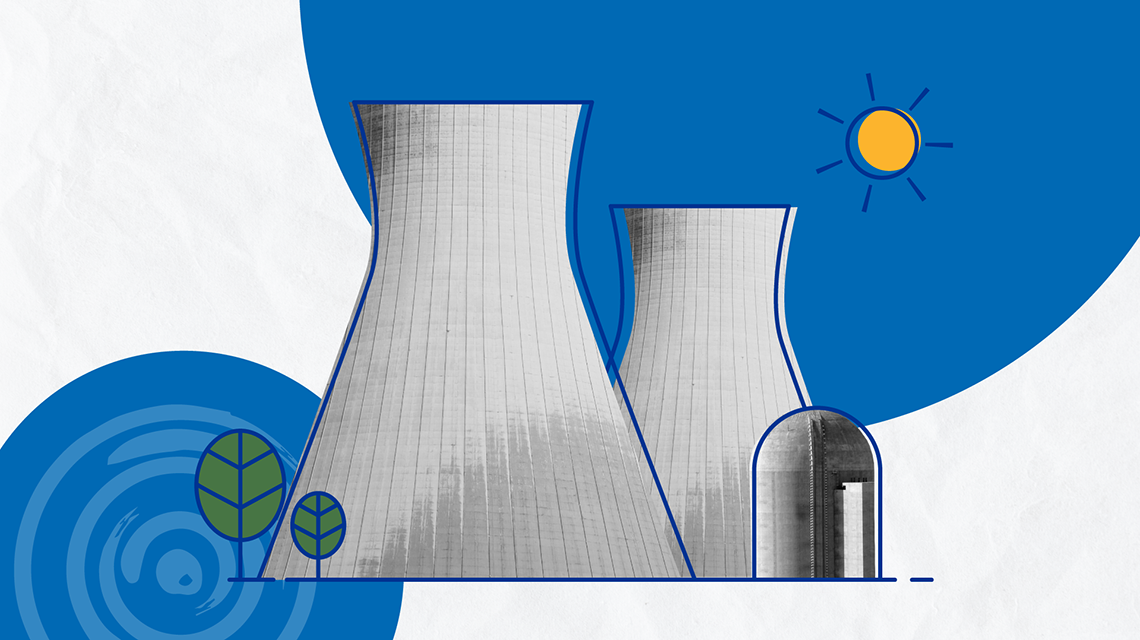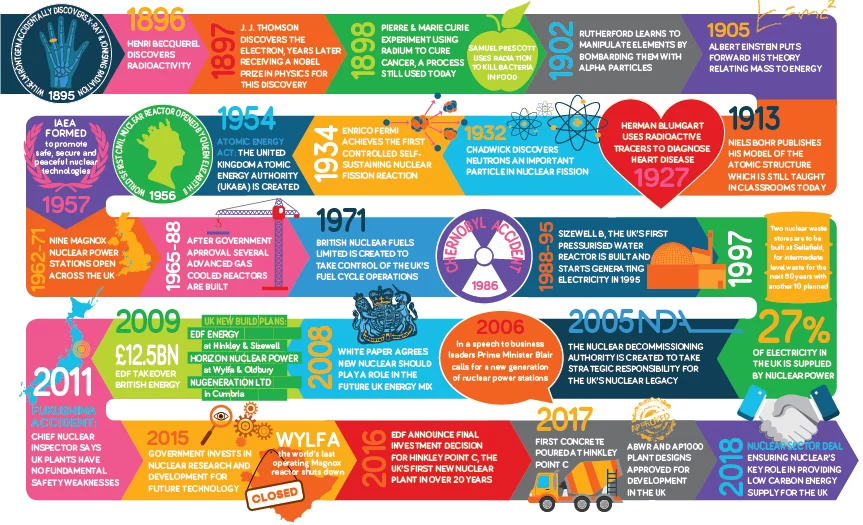China: Usurping the US as Nuclear Powerhouse?
Chinese Nuclear Energy Development and United States Pledge
Dec 27, 2023
Hello!
Thesis: Throughout history, energy capacity has determined the industrial and financial capacities of developing nations. As modern nations continue to develop exponentially, as in recent times with the development of AI and quantum computing (among many other examples), energy needs to be able to scale effectively.
If you haven’t read my nuclear energy primer, I’d highly recommend it before reading this article as some of the terminology associated with nuclear energy is difficult to understand without a decent background in the field.

Credit International Atomic Energy Association
Let’s start by discussing the current state of nuclear power from a broad standpoint.
The first commercial nuclear power stations started operation in the 1950s.
Fast forward 70 years and we now have 440 power reacnators providing around 10% of the world’s electricity.
But how did we get here?

Credit Nuclear Industry Association
Nuclear technology was first developed in the 1940s and during World War II research initially focused on producing bombs (think Manhattan Project). In the 1950s, attention turned to the peaceful use of nuclear fission, which led to the commercialization of nuclear energy.
In the late 50s and 60s, the United States through a company called Westinghouse designed the first fully commercial pressurized water reactor (PWR) which eventually stopped operation in 1992.
In Canada, reactors looked slightly different at first, using heavy water (PHWR) models to produce their famous CANDU reactors starting in 1962.
France began with a gas-graphite design, beginning operation in 1959.
In 1964, the first Russian nuclear power plants were built.
In Kazakhstan, the world’s first fast neutron reactor started in 1972.
From the late 1970s to about 2002 the nuclear power industry suffered some decline and stagnation. Few new reactors were built with the number beginning operation little more than matching the number of retirements, though capacity increased by nearly one-third and output increased by 60% due to capacity plus improved load factors.
However, by the late 1990s, the first of the third-generation reactors was commissioned – a 1350 MWe Advanced Boiling Water Reactor, in Japan. This was a sign of the recovery to come.
Credit Statista
That brings us to the topic of today and recent developments.
In the process of world nuclear research, development, construction, and operation, humanity has achieved more than 20,000 reactor years of nuclear experience, not a small feat. In addition, nuclear power plants are operational in 31 countries, with 13 of those countries producing at least 25% of their electricity from nuclear power plants.
Yet, even with all of the substantial research and development of world nuclear energy, there is still a clear need for new generating capacity around the world, both to replace fossil fuels and to meet the increased demand for electricity in many countries.
So who is stepping up to bat?
It’s looking like China and India trying to dethrone the United States.
This is not an article on India (hopefully coming later), but it is a commentary on China vs. the United States. So let’s start with the challenger:
China: Nuclear Energy Capabilities and Future Plans
If I had to summarize China’s recent attitude towards nuclear energy in 1 sentence:
China’s approach to nuclear energy has been efficient, effective, and scary.
A recent article from the Economist on November 30th, 2023 begins with the headline “China is building nuclear reactors faster than any other country.”
Let’s dissect what this means.
China is doing what we hoped the United States would be doing right about now.
That’s a wild statement, but I think it accurately represents the situation at hand. China currently runs most of its energy capacity off of fossil fuels (see graphs below). In recent years, they have spent substantially on wind and solar energy, but also in the category of nuclear.
Credit International Trade Administration
Over the past decade, China has added 37 nuclear reactors, for a total of 55, according to the International Atomic Energy Agency. During that same period America, which leads the world with 93 reactors, added two.
In addition, it is speculated that China has around 20 reactors currently under construction, with a commitment to install between 6-8 new reactors every year. If that isn’t efficient, effective, and scary, I don’t know what is.
What’s even scarier is the overall nuclear atmosphere in China compared to the United States.
In the United States, where nuclear power has mostly stalled, reactors require large upfront investment, are heavily regulated, and take years to construct. Contrast that with China where they provide state-owned energy companies with cheap loans, land, and licenses.
In economic terms, this supply of the components of nuclear energy has drastically increased the ability of these companies (for more information on this topic research subsidy economics), leading to the price of nuclear power dropping to around $70 per megawatt hour in China compared to the $105 it currently is in America (not to mention Europe is around $160).
25% cheaper energy.
At this rate, China will surpass the United States in terms of raw nuclear power in the next 5-10 years while paying less for every single particle of energy it creates. Scary?
United States: Nuclear Energy Capabilities and Future Plans
A picture says a thousand words.
Credit US Energy Information Administration
Given the information above about China’s nuclear potential and emphasis, what is the United States doing to maintain its status as the “World’s Nuclear Powerhouse”?
Short answer: Not much.
If I had to summarize the United States’ recent attitude towards nuclear energy in 1 sentence:
The United States’ approach to nuclear energy has been mainly noise, with little action.
Consider the recent United Nations Climate Summit in Dubai. 21 Nations (the United States among them) pledged to triple nuclear energy capacity by 2050. It’s a great goal, but is it really feasible?
Can we simply increase the current capacity of existing reactors by 3x in the next 25 years? Probably not. So, we’re going to have to build some new reactors.
How many new reactors? Let’s do some bad math. We currently have 93 reactors and we want to triple the current capacity, so let’s assume we would have to build around 150+ reactors. Wait, but how many of our current reactors are going to be decommissioned in the next 25 years?
Reuters reports the following quote from the Department of Energy “Under current license basis 92% of operating reactors would shut down by 2050 and 74 percent would shut down by 2050 with anticipated license renewals. However, if 54 reactors extended operation to 80 years, only 20% of operating reactors would shut down by 2050.”
Doing bad math, that assumes that anywhere between 18 - 66 reactors have to shut down by 2050 (giving us between 72-24 reactors left). So we probably need to build even more to achieve our target. If we take the current 93 reactors and want to triple production, we assume a total of around 270 to triple production, meaning we would have to reasonably build anywhere between 175 - 225 reactors given the planned reactor decommissions.
Let’s use 200 as a simple median point.
Historical data rates put the United States at around 7-10 years on average to build a nuclear reactor. Add in that passing regulation takes around 3-5 years and we’re already at 10-15 years. So if we started right now to build new reactors, they would potentially be done as early as 2033 - 2038.
But are we going to start building 200 reactors right now? Probably not, but assuming worst-case scenarios where we start building to achieve operation right at the 2050 timeline, we would have to build by 2035 - 2040, which gives us around a decade to get our act together at the most.
Is this possible? Maybe. But we haven’t even started talking about costs.
How much (on average) does it cost to build a nuclear reactor in the United States?
Conservative estimates have put the cost of building a nuclear reactor around $6 - 9 billion dollars, although the last 2 reactors the United States built (Vogtle 3 & 4) cost around $30 billion.
Again more bad math.
So the overall cost of building all of these nuclear reactors over the next 25 years will be around $1 - $2 Trillion. For fun, let’s assume that the United States chooses to raise taxes instead of issuing bonds for these projects.
$1.5 Trillion over 25 years = $60 Billion a year. Considering that the United States generates around $5 Trillion per year in income taxes, this would raise the average tax rate by 1.2% every year for the next 25 years.
Takeaways
There are many takeaways from this article today. I’ll detail some below and why I think they are important to consider.
1. This is a great time to enter the world of nuclear energy in the United States. That money has to go somewhere (construction, designers, architects, researchers, etc.)
2. As it currently stands, China is on a trajectory to surpass the United States in the next 5-10 years.
3. For the United States to achieve our nuclear energy targets, we essentially need to build more reactors than we have built in the last 80 years (137 total) in just the next 10-15 years. Does that seem possible?
Yet, there is some good to come out of this discussion. A main benefit, however small, in my opinion, is simply that people are actually starting to see the value in nuclear (even if that is China) as a reliable energy source for our future that we should be actively pursuing. Historically, this has been more than half of the battle of adopting innovative technology, so we’re on the right track.
It also helps that countries have to compete against their rivals – in this case for good.
So, is this the Arms Race 2.0, the “Energy Race”?
It’s not so much of a race as it is a worldwide initiative. To hit many of the climate pledges in recent years by the deadlines set (generally 2030 - 2050) as well as sustain the rapid growth of developing and modern nations, countries have to engage in rapid research, development, and overall innovation in order to have enough sustainable and long-term energy solutions in place for humanity's future.
Is nuclear that solution? You'll have to decide for yourself.
Anywho, that’s all for today.
-Drew Jackson
Disclaimer:
The views expressed in this blog are my own and do not represent the views of any companies I currently work for or have previously worked for. This blog does not contain financial advice - it is for informational and educational purposes only. Investing contains risks and readers should conduct their own due diligence and/or consult a financial advisor before making any investment decisions. This blog has not been sponsored or endorsed by any companies mentioned.






